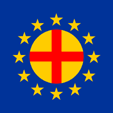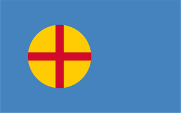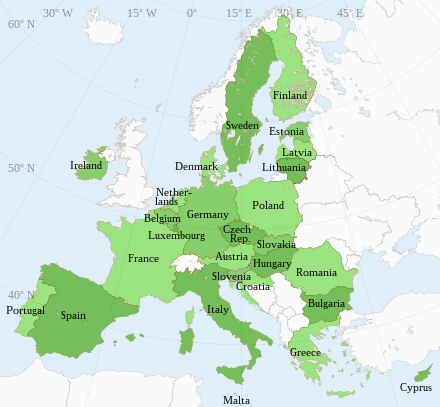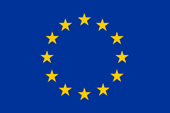
1986 hat sich der Rat auf die Europäische Flagge geeinigt, die zum Emblem der Europäischen Union wurde. Sie zeigt einen Kranz von zwölf goldenen fünfstrahligen Sternen, deren Spitzen sich nicht berühren, auf kobaltblauem Hintergrund, als Zeichen der Union der Völker Europas. Da die Zahl Zwölf als Symbol für Vollkommenheit und Einheit gilt, ist sie unveränderlich. Die zwölf Sterne stehen somit nicht für die Anzahl der Mitgliedsstaaten. Die Farben sind im Leitfaden der Europäischen Kommission von 1996 und im Leitfaden des Europarats von 2004 entsprechend geregelt, und zwar als Blau = CMYK 100|80|0|0, was Pantone Reflex Blue entsprechen würde und als Gelb = CMYK 0|21|100|0, was Pantone 123 entsprechen würde.
Quelle: Wikipedia (EN)


Flagge der Paneuropa Bewegung,
Dank an Peter Diem, Media Research, peter-diem.at

Von Richard Graf von Coudenhove-Kalergi
im Jahre 1952 vorgeschlagene Flagge für Europa,
Quelle, nach: kohoutikriz.org

Richard Graf von Coudenhove-Kalergi, ein politischer Schriftsteller, * 16.11.1894 Tokio, † 27.07.1972 Schruns (Vorarlberg), war der Gründer und Generalsekretär der Paneuropabewegung. Neben vielen Schriften zur europäischen Einigung schuf er in den zwanziger Jahren des 19. Jahrhunderts die Paneuropaflagge. Sie war quadratisch und trug ein rotes Kreuz inmitten einer goldene Scheibe, umgeben von einem Kranz aus zwölf goldenen fünfzackigen Sternen, auf einem dunkelblauen Grundtuch. Nach der Gründung des Europarats im Jahre 1949 wurden verschiedene Vorschläge für eine Flagge für diese Organisation gemacht. Coudenhove-Kalergi schlug im Jahre 1952 eine Flagge vor, die derjenigen der Paneuropabewegung ähnlich war, jedoch trug sie nicht die zwölf Sterne. Auf Grund ihres christlichen Erscheinungsbildes wurde sie von der Türkei abgelehnt. (siehe auch diesen Link beim Europarat selbt: https://www.coe.int/en/web/documents-records-archives-information/european-flag)
Quelle: Volker Preuß
Paul M. G. Lévi, der Leiter der Kulturabteilung des Europarats, schuf Anfang der 50-er Jahre eine Flagge für den Europarat. Er schlug zunächst eine Flagge vor die derjenigen der Paneuropabewegung ähnlich war. Jedoch enthielt sie nicht mehr die goldene Scheibe und das Kreuz, und die Anzahl der Sterne hatte sich auf fünfzehn erhöht. Diese sollten die Mitgliedsstaaten im Europarat repräsentieren. Da dieses Konzept das Saarland (als eigenständiges Mitglied des Europarates) mit eingeschlossen hätte, lehnte Deutschland diesen Entwurf ab. Seit seiner Gründung im Jahre 1949, war sich der Europarat der Notwendigkeit bewusst, Europa ein Symbol zu geben, mit dem sich seine Einwohner identifizieren können. Am 25.10.1955 fiel in der Parlamentarischen Versammlung die einstimmige Entscheidung einen Kreis goldener Sterne auf blauem Hintergrund als Emblem anzunehmen. Am 08.12.1955 nahm das Ministerkomitee dieses als die Europäische Flagge an: Am blauen Himmel der Westlichen Hemisphäre, repräsentieren die Sterne die Völker Europas in einem Kreis, das Symbol der Einheit. Ihre Anzahl soll immer zwölf sein, das Symbol für Vollkommenheit und Vollendung. So wie die zwölf Tierkreiszeichen das gesamte Universum repräsentieren, stehen die zwölf goldenen Sterne für alle Völker Europas, diejenigen eingeschlossen, die noch nicht am Bau Europas in Einheit und Frieden teilhaben können. Am 11.4.1983 nahm das Europäische Parlament diese Flagge als das offizielle Symbol für die Europäische Union an.
Quelle: Peter Diem, Media Research, Wien, peter-diem.at/, gestützt auf offizielle Texte des Europarates und zeitgenössische Medienberichte
Über die Motivation und den Antrieb der in die Europäische Flaggengeschichte verwickelten Personen gibt es recht unterschiedliche Darstellungen. Drei von diesen sollen hier kurz präsentiert werden:
• Die zwölf Sterne, vor allem die in der von Richard Graf von Coudenhove-Kalergi geschaffenen Flagge der Paneuropabewegung, sollen aus der biblischen "Apokalypse des Johannes" (Offenbarung 12,1) stammen: "Und es erschien ein großes Zeichen am Himmel: eine Frau, mit der Sonne bekleidet, und der Mond unter ihren Füßen und auf ihrem Haupt eine Krone von zwölf Sternen." Dieser Gedanke sei dann von der zwölfsternigen Flagge der Paneuropabewegung auf die zwölfsternige Flagge der EU übergegangen.
• Die Europaflagge habe ihren Ursprung in der Zeit des Zweiten Weltkriegs. Paul M. G. Lévi, ein Belgier jüdischer Abstammung, legte das Gelübde ab, das er, wenn den Krieg lebend überstehen würde, zum katholischen Glauben konvertieren wolle. Er überlebte und wurde katholisch. Am 5. Mai 1949 wurde in London der Europarat gegründet, und Paul Lévi wurde Leiter der Kulturabteilung des Europarats. In der 1952 aufkommenden Flaggendiskussion seien sämtliche Entwürfe, in denen, etwa nach dem Vorbild der skandinavischen Flaggen, ein Kreuz enthalten war, von den Sozialisten als ideologisch gebunden und als zu christlich verworfen worden. Eines Tages sei Lévi an einer Marienstatue mit einem Sternenkranz vorbeigekommen. Durch die Sonne beschienen, leuchteten die goldenen Sterne vor dem blauem Himmel. Lévi habe daraufhin Graf Benvenuti aufgesucht, einen venezianischen Christdemokraten und damaliger Generalsekretär des Europarats, und schlug ihm vor, zwölf goldene Sterne auf blauem Grund als Motiv für die Europafahne vorzuschlagen, was allgemein akzeptiert wurde.
• Paul M. G. Lévi, der Leiter der Kulturabteilung des Europarats, sei als Jude von antichristlichen Vorstellungen geleitet gewesen, als er die Flagge schuf. Grundgedanke sei die Ablehnung der bisherigen Paneuropaflagge gewesen, da diese ein Kreuz enthielt, und so Assoziationen zum Christentum zugelassen habe. Die Geschichte um den Sternenkranz Marias sei von ihm nur erfunden worden, um den Wegfall des Kreuzes irgendwie auszugleichen, und um die Flagge dennoch, und vor allem bei Katholiken beliebt zu machen.
Quelle: Jörg Roggenbuck
Während Richard Graf von Coudenhove-Kalergi (1894–1972) in einer persönlichen Erklärung bekräftigte, dass drei führende Katholiken innerhalb des Europarats "unterbewusst" die zwölf Sterne nach dem Vorbild der biblischen "Apokalypse des Johannes" (Offenbarung 12,1) gewählt hätten, erklärte Paul M. G. Lévi, Pressebeamter des Europarats von 1949 bis 1966, im Jahre 1989, dass es keine religiösen Intentionen – oder was auch immer damit verbunden wird – bei der Auswahl des Kreises mit den zwölf Sternen gegeben habe. Die Zahl Zwölf wurde als Symbol für Vollkommenheit and Beständigkeit ausgewählt.
Quelle: Peter Diem, Media Research, Wien, peter-diem.at/

Landkarte der Mitgliedsstaaten:

Quelle/Source: wikimedia.org

Fläche: 4.234.564 km²
Einwohner: 446.800.000 (2022), davon 18% Deutsche, 15% Franzosen, 13% Italiener, 10% Spanier
Bevölkerungsdichte: 106 Ew./km²
Hauptstädte:
– Sitz Rat/Kommission: Brüssel
– Sitz des Parlaments: Straßburg
– Sitz des Gerichtshofs: Luxemburg
Währung: 1 Euro (EUR, €) = 100 Cent
Zeitzone: MEZ – 1 bis + 2 h
Quelle:
Wikipedia (DE)

Belgien
Bulgarien
Dänemark
Deutschland
Estland
Finnland
Frankreich
Griechenland
Irland
Italien
Kroatien
Lettland
Litauen
Luxemburg
Malta
Niederlande
Österreich
Polen
Portugal
Rumänien
Schweden
Slowakei
Slowenien
Spanien
Südzypern
Tschechei
Ungarn

1951 · Der Weg zur Europäischen Union hat 1951 begonnen. Damals gründeten sechs westeuropäische Staaten in Paris die Europäische Gemeinschaft für Kohle und Stahl (EGKS). Es waren: Belgien, die Bundesrepublik Deutschland, Frankreich, Italien, Luxemburg und die Niederlande. Sie hatten von Anfang an Größeres vor, als nur einen gemeinsamen Markt für Kohle und Stahl zu bilden. Im Gründungsvertrag heißt es, die sechs Staaten seien entschlossen, "durch die Errichtung einer wirtschaftlichen Gemeinschaft den ersten Grundstein für eine weitere und vertiefte Gemeinschaft unter Völkern zu legen, die lange Zeit durch blutige Auseinandersetzungen entzweit waren".
1957 · Diese sechs EGKS-Staaten gründeten in Rom die Europäische Wirtschaftsgemeinschaft (EWG) und die Europäische Atomgemeinschaft (EURATOM). Sie hatten "den festen Willen, die Grundlagen für einen immer engeren Zusammenschluss der europäischen Völker zu schaffen", wie dies im Gründungsvertrag der EWG heißt. In der EWG wurde die gemeinsame Politik vom Bereich Kohle und Stahl auf weitere Bereiche der Wirtschaft ausgedehnt, z.B. auf die Landwirtschaft, die Fischerei, das Verkehrswesen, das Wettbewerbsrecht und den den Außenhandel. Die Mitgliedsstaaten beschlossen, innerhalb von zwölf Jahren einen gemeinsamen Markt zu bilden, also einen Binnenmarkt. Das dauerte dann doch länger, aber Anfang 1993 war es so weit: Der Binnenmarkt wurde "eröffnet".
1968 · Die EWG hat die Zollunion vollendet: Seither sind Importe und Exporte zwischen EWG-Staaten zollfrei.
1972 · Die EWG-Staaten beschlossen, dass sie auf weiteren Gebieten der Politik zusammenarbeiten: Energiepolitik, Regionalpolitik, Umweltpolitik.
1973 · Aus sechs wurden neun: Dänemark, Irland und das Vereinigte Königreich von Großbritannien und Nordirland traten EWG, EGKS und EURATOM bei.
1979 · Zum erstenmal wurden die Abgeordneten des Europäischen Parlaments direkt von den Wahlberechtigten in den neun Staaten der Gemeinschaft gewählt.
1981 · Von nun an waren es zehn: Griechenland trat bei.
1986 · Die Anzahl der Mitgliedsstaaten erhöhte sich auf zwölf: Portugal und Spanien traten bei. Im gleichen Jahr beschlossen die Mitgliedsstaaten eine erste umfassende Änderung der Gründungsverträge, die Einheitliche Europäische Akte, und setzten ein Datum für die Vollendung des Binnenmarktes 1992.
1992 · Die Zwölf Staaten unterzeichneten in der niederländischen Stadt Maastricht den "Vertrag über die Europäische Union". Er trat am 1. November 1993 in Kraft. Sie erweiterte die Bereiche der Politik, in denen sie zusammenarbeiteten. Hinzu kamen jetzt: Bildung, Kultur, Gesundheitswesen, Verbraucherschutz, Industrie, Entwicklungshilfe, Außen- und Sicherheitspolitik, Justiz, Inneres.
1993 · Der Binnenmarkt ist seit 1. Januar 1993 verwirklicht.
1995 · Drei weitere Staaten sind beigetreten: Finnland, Österreich und Schweden.
1997 · Auf dem Gipfeltreffen in Amsterdam im Juni wurden der Stabilitäts- und Wachstumspakt sowie umfassende Änderungen der bestehenden Verträge verabschiedet.
1999 · Am 1. Januar: Beginn der Europäischen Währungsunion in elf Staaten der EU. Im 1. Halbjahr hatte Deutschland die Präsidentschaft in der EU inne. Auf dem Gipfeltreffen des Europäischen Rates in Berlin wurde die "Agenda 2000" verabschiedet, auf dem Gipfel in Köln der Europäische Beschäftigungspakt.
2002 · Der Euro kommt als Bargeld: Am 1. Januar werden die Euro-Banknoten und Euro-Münzen ausgegeben.
2004 · Die Anzahl der Mitgliedsstaaten erhöhte sich auf fünfundzwanzig: Litauen, Lettland, Estland, Malta, Slowenien, Ungarn, Slowakei, Tschechei, Polen und Südzypern traten bei.
2005 · Der Versuch der Einführung einer "Europäischen Verfassung" scheitert zunächst am "Nein" der in einer Volksabstimmung befragten französischen und niederländischen Bevölkerung. Darauf hin hat Großbritannien das Referendum auf unbestimmte Zeit verschoben. In vielen anderen Europäischen Staaten stimmten ausschließlich Politiker über die Annahme der "Europäischen Verfassung" ab, und diese waren im Gegensatz zur Bevölkerung meist mehrheitlich dafür.
2007 · Rumänien und Bulgarien werden Mitglieder der Europäischen Union
2008 · Der Versuch der Einführung eines "Europäischen Vertrages" anstelle einer "Europäischen Verfassung" scheitert am "Nein" der in einer Volksabstimmung befragten irischen Bevölkerung. Der Präsident Polens verkündet den Vertrag nicht unterschreiben zu wollen.
2013 · Kroatien wird Mitglied der Europäischen Union
2016 · Eine Volksabstimmung in Großbritannien entscheidet mehrheitlich für ein Verlassen der Europäischen Union
31.01.2020 · Großbritannien verlässt die Europäische Union
Quelle: Volker Preuß

Das Wort "Europa" hat seine Wurzeln im semitischen Wort "Ereb", was "Abend" heißt. Europa ist das "Abendland".
Quelle: Handbuch der geographischen Namen


![]()







![]()
